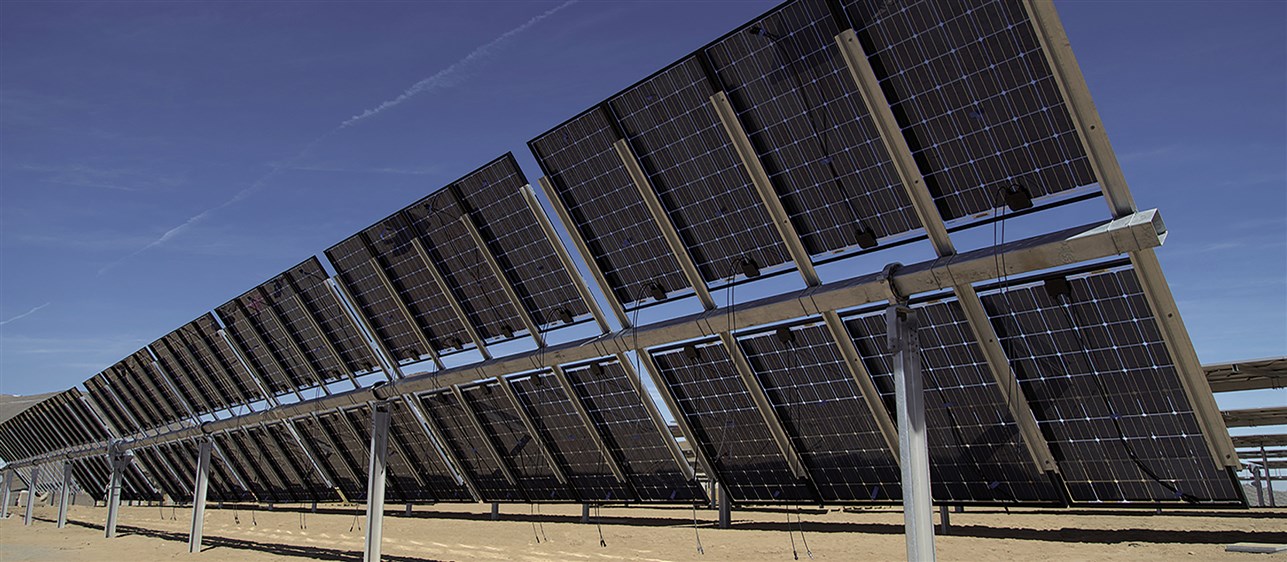
Location
Madonah, Jordan, Middle East
Overview
Considered Jordan’s largest privately-owned wheeling project, the 100 MW photovoltaic plant at Madonah has two main objectives: reducing the environmental impact of the 87 industrial entities which drove its development and increasing the competitiveness of Jordan’s industrial sector by reducing energy costs. The Specialised Sun for Renewable Energy – a special-purpose company established to deliver the photovoltaic plant – commissioned Dar to provide advisory services covering the whole lifecycle of the project: feasibility study, plant optimisation, energy yield simulation, preparation of tender documents, tender assessment and negotiations, construction supervision and performance monitoring after operation.
Markets
The project
The Madonah PV Plant uses bifacial photovoltaic plants and a single axis tracking system that shifts photovoltaic panels to track the trajectory of the sun, effectively ensuring that a photovoltaic plant can produce more electricity.
With a land area of two million m2, the plant has a nominal capacity of 135 MWp DC / 100 MW AC and is integrated with the transmission company, the National Electric Power Company (NEPCO), at 400 kV level. The PV plant will step up its 100 MW output from 33 kV to 400 kV through its step-up 2x120 MVA air insulated substation, and deliver power to NEPCO’s 400 kV grid through a new 400 kV overhead double circuit transmission line. This circuit will connect the PV plant with NEPCO’s existing IPP3 400 kV switchyard, which will be expanded to accommodate the connection of the new line.
In order to deliver a project that would meet our client’s key objectives, Dar’s technical experts focused on maximising the plant’s annual energy yield, while also ensuring that the Client’s financial acceptance criteria are still met. In line with this vision, Dar introduced a number of effective design solutions including:
- Choosing high-efficiency, high-power photovoltaic panels that would optimise land utilisation.
- Implementing a single axis tracking system to maximise the irradiation gain and consequently the system’s annual energy yield.
- Adopting a backtracking algorithm to eliminate/minimise the shading between rows while maximising the distance between rows (pitch) to increase the useful trackers range and hence the annual energy yield.
- Adopting the most financially optimised DC/AC ratio by conducting incremental analysis, in order to:
- Maximise the plant’s annual energy yield out of the pre-determined AC capacity of 100 MW thus positively affecting each shareholder’s allocation of generated clean energy.
- Minimising the percentage of degradation in energy output at the plant level as curtailment loss percentage will be decreased over the lifetime.
While preparing specifications for the contractor, Dar also introduced a new key performance indicator – the irradiation gain factor – to complement performance ratio, the market’s typical performance indicator. The irradiation gain factor is calculated by dividing the annual irradiation at the plane of array by the annual horizontal irradiation, with both quantities measured by Class A pyranometers. The new factor accounts for the tracking systems and will empower contractors, operators, and other stakeholders to predict and measure the accurate performance of the new plant and make informed decisions that optimise that performance.
Aiming to maximise the project’s performance certainty, Dar included a new acceptance criterion for the Current-Voltage (IV) curve test measurements. The criterion was modified from the typical criteria adopted in the market (as per IEC 62446-1) to be as follows:
- Each string will be considered as pass in IV Curve testing if its maximum power value at STC lies within the accuracy range of the measurement device.
- Considering that the measurement device has both positive and negative accuracy and that the number of panels is large enough to consider that the measurements will follow the normal distribution curve, the average value of all strings’ maximum power at Standard Testing Conditions (STC) when compared to the nominal value shall not have a negative variation exceeding 0.25 times the device measurement accuracy (e.g. maximum of -1.25% for +-5% device).
